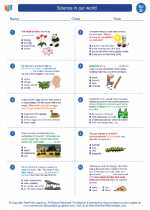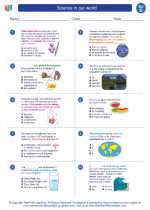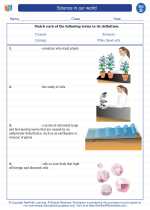Terrestrial Ecosystems
A terrestrial ecosystem is a community of living organisms and their physical environment, functioning together as a unit. These ecosystems are found on land and are distinguished by the type of vegetation present, the climate, and the topography of the land.
Components of Terrestrial Ecosystems
- Producers: These are the plants and other photosynthetic organisms that produce their own food using sunlight, water, and carbon dioxide.
- Consumers: These are the animals that feed on the producers or other consumers.
- Decomposers: These are organisms like bacteria and fungi that break down dead organic matter, releasing nutrients back into the ecosystem.
- Abiotic Factors: These are the non-living components of the ecosystem such as sunlight, temperature, water, soil, and air.
Types of Terrestrial Ecosystems
There are several types of terrestrial ecosystems, each with its own unique characteristics:
- Forest Ecosystems: These are dominated by trees and are found in diverse climates around the world. They can be further classified as tropical, temperate, or boreal forests.
- Grassland Ecosystems: These are characterized by grasses and other herbaceous plants, and are found in both tropical and temperate regions.
- Desert Ecosystems: These are arid environments with sparse vegetation and extreme temperature variations.
- Tundra Ecosystems: These are found in cold, treeless regions and are characterized by permafrost and low-growing vegetation.
- Mountain Ecosystems: These are found at high altitudes and are characterized by steep terrain, low temperatures, and unique plant and animal adaptations.
Factors Affecting Terrestrial Ecosystems
Several factors can affect terrestrial ecosystems, including:
- Climate: Temperature, precipitation, and seasonal variations can have a significant impact on the types of organisms that can survive in a particular ecosystem.
- Human Activity: Deforestation, urbanization, and pollution can all disrupt terrestrial ecosystems and lead to loss of biodiversity.
- Natural Disasters: Events such as wildfires, floods, and earthquakes can also have a significant impact on terrestrial ecosystems.
Study Guide
To study terrestrial ecosystems, consider the following key points:
- Identify and describe the different components of a terrestrial ecosystem.
- Compare and contrast the characteristics of forest, grassland, desert, tundra, and mountain ecosystems.
- Explain the importance of abiotic factors in shaping terrestrial ecosystems.
- Analyze the impact of human activity on terrestrial ecosystems and propose possible solutions to mitigate these effects.
- Discuss the role of terrestrial ecosystems in the carbon and water cycles, and their importance in maintaining the overall balance of the planet.
By understanding the components, types, and factors affecting terrestrial ecosystems, you will gain a comprehensive understanding of this important aspect of our natural world.
.◂Science Worksheets and Study Guides Fourth Grade. Science in our world
Study Guide Science in our world - 4th gr.
Science in our world - 4th gr.  Worksheet/Answer key
Worksheet/Answer key Science in our world - 4th gr.
Science in our world - 4th gr.  Worksheet/Answer key
Worksheet/Answer key Science in our world - 4th gr.
Science in our world - 4th gr.  Worksheet/Answer key
Worksheet/Answer key Science in our world - 4th gr.
Science in our world - 4th gr.  Vocabulary/Answer key
Vocabulary/Answer key Science in our world - 4th gr.
Science in our world - 4th gr. 

 Worksheet/Answer key
Worksheet/Answer key
 Worksheet/Answer key
Worksheet/Answer key
 Worksheet/Answer key
Worksheet/Answer key
 Vocabulary/Answer key
Vocabulary/Answer key

The resources above cover the following skills:
History and Nature of Science: A student should understand the history and nature of science. A student who meets the content standard should:
Develop an understanding that historical perspectives of scientific explanations demonstrate that scientific knowledge changes over time, building on prior knowledge.
Develop an understanding that scientific knowledge is ongoing and subject to change as new evidence becomes available through experimental and/or observational confirmation(s).